University Dissertation: Water Play and Child Development Outdoors
VerifiedAdded on 2022/08/14
|28
|8185
|33
Thesis and Dissertation
AI Summary
This dissertation explores the role of water play in facilitating child development within an outdoor setting. The study investigates the perceptions of educators regarding children's engagement in water play and identifies ways children interact with water in outdoor areas. The research delves into the benefits of water play, including its impact on cognitive, social-emotional, and motor development, and its potential to foster cooperation and spatial thinking skills. The literature review covers various types of play, the role of adults in supporting play, and the significance of outdoor environments for learning. The dissertation emphasizes the importance of balancing practitioner-led and child-initiated play to support holistic development. It also highlights the need for more primary research on water play activities in early childhood settings, providing a rationale for conducting qualitative research to understand the child-water interaction. The study aims to contribute to the understanding of how water play can be effectively incorporated into early childhood education to enhance children's learning experiences.

Running Head: EARLY CHILDHOOD STUDIES
EARLY CHILDHOOD STUDIES
Name of the Student
Name of the university
Author’s note
EARLY CHILDHOOD STUDIES
Name of the Student
Name of the university
Author’s note
Paraphrase This Document
Need a fresh take? Get an instant paraphrase of this document with our AI Paraphraser
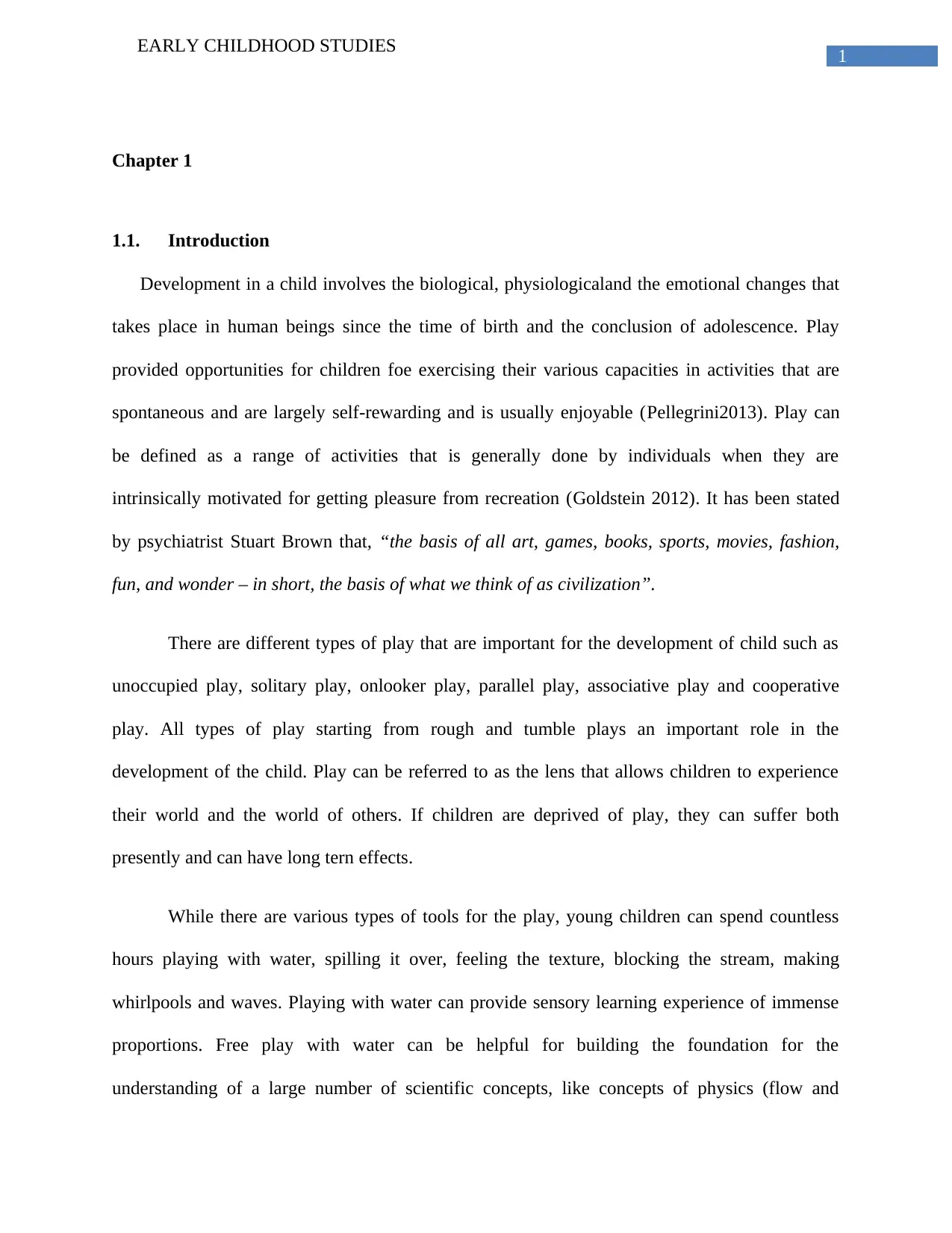
1
EARLY CHILDHOOD STUDIES
Chapter 1
1.1. Introduction
Development in a child involves the biological, physiologicaland the emotional changes that
takes place in human beings since the time of birth and the conclusion of adolescence. Play
provided opportunities for children foe exercising their various capacities in activities that are
spontaneous and are largely self-rewarding and is usually enjoyable (Pellegrini2013). Play can
be defined as a range of activities that is generally done by individuals when they are
intrinsically motivated for getting pleasure from recreation (Goldstein 2012). It has been stated
by psychiatrist Stuart Brown that, “the basis of all art, games, books, sports, movies, fashion,
fun, and wonder – in short, the basis of what we think of as civilization”.
There are different types of play that are important for the development of child such as
unoccupied play, solitary play, onlooker play, parallel play, associative play and cooperative
play. All types of play starting from rough and tumble plays an important role in the
development of the child. Play can be referred to as the lens that allows children to experience
their world and the world of others. If children are deprived of play, they can suffer both
presently and can have long tern effects.
While there are various types of tools for the play, young children can spend countless
hours playing with water, spilling it over, feeling the texture, blocking the stream, making
whirlpools and waves. Playing with water can provide sensory learning experience of immense
proportions. Free play with water can be helpful for building the foundation for the
understanding of a large number of scientific concepts, like concepts of physics (flow and
EARLY CHILDHOOD STUDIES
Chapter 1
1.1. Introduction
Development in a child involves the biological, physiologicaland the emotional changes that
takes place in human beings since the time of birth and the conclusion of adolescence. Play
provided opportunities for children foe exercising their various capacities in activities that are
spontaneous and are largely self-rewarding and is usually enjoyable (Pellegrini2013). Play can
be defined as a range of activities that is generally done by individuals when they are
intrinsically motivated for getting pleasure from recreation (Goldstein 2012). It has been stated
by psychiatrist Stuart Brown that, “the basis of all art, games, books, sports, movies, fashion,
fun, and wonder – in short, the basis of what we think of as civilization”.
There are different types of play that are important for the development of child such as
unoccupied play, solitary play, onlooker play, parallel play, associative play and cooperative
play. All types of play starting from rough and tumble plays an important role in the
development of the child. Play can be referred to as the lens that allows children to experience
their world and the world of others. If children are deprived of play, they can suffer both
presently and can have long tern effects.
While there are various types of tools for the play, young children can spend countless
hours playing with water, spilling it over, feeling the texture, blocking the stream, making
whirlpools and waves. Playing with water can provide sensory learning experience of immense
proportions. Free play with water can be helpful for building the foundation for the
understanding of a large number of scientific concepts, like concepts of physics (flow and
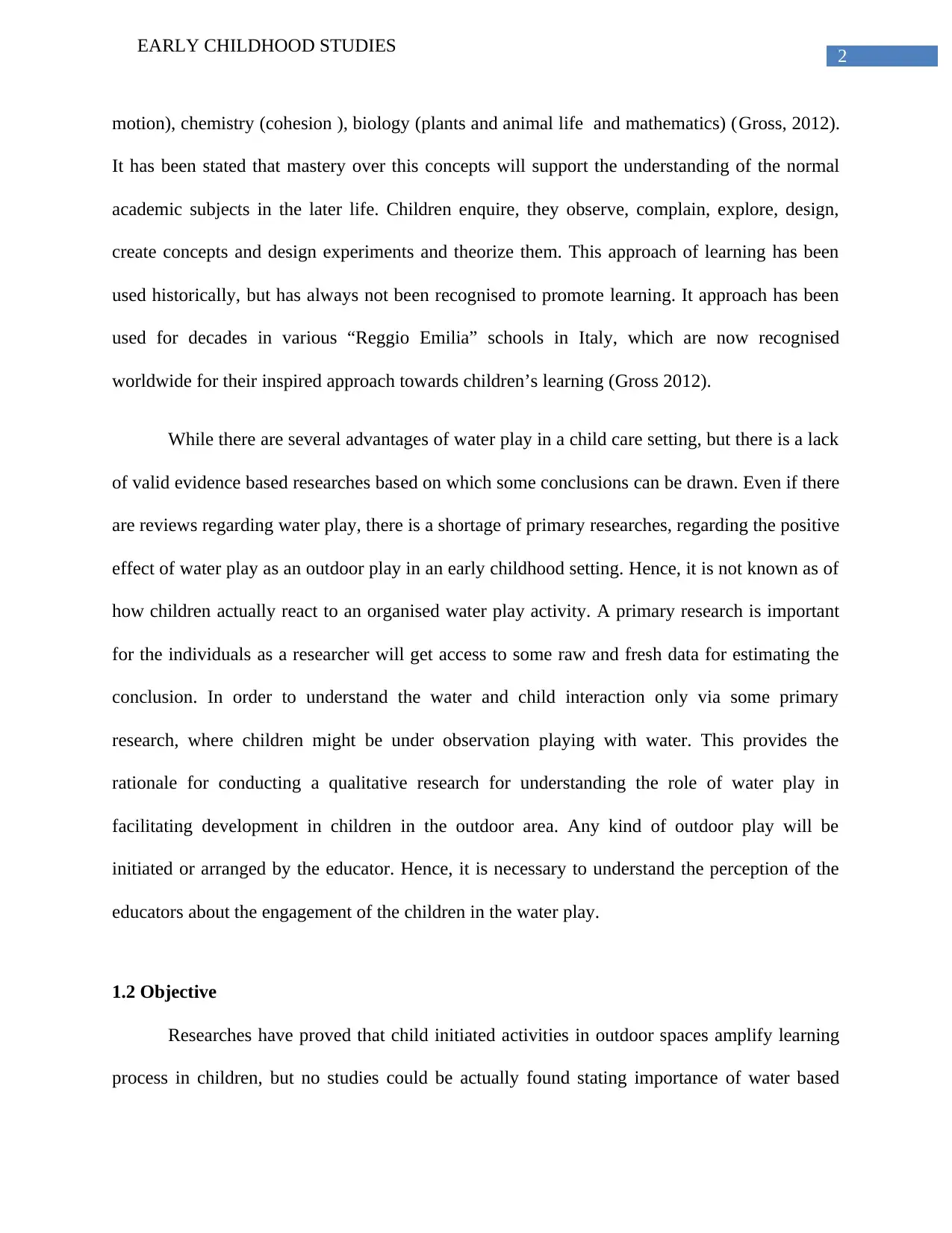
2
EARLY CHILDHOOD STUDIES
motion), chemistry (cohesion ), biology (plants and animal life and mathematics) (Gross, 2012).
It has been stated that mastery over this concepts will support the understanding of the normal
academic subjects in the later life. Children enquire, they observe, complain, explore, design,
create concepts and design experiments and theorize them. This approach of learning has been
used historically, but has always not been recognised to promote learning. It approach has been
used for decades in various “Reggio Emilia” schools in Italy, which are now recognised
worldwide for their inspired approach towards children’s learning (Gross 2012).
While there are several advantages of water play in a child care setting, but there is a lack
of valid evidence based researches based on which some conclusions can be drawn. Even if there
are reviews regarding water play, there is a shortage of primary researches, regarding the positive
effect of water play as an outdoor play in an early childhood setting. Hence, it is not known as of
how children actually react to an organised water play activity. A primary research is important
for the individuals as a researcher will get access to some raw and fresh data for estimating the
conclusion. In order to understand the water and child interaction only via some primary
research, where children might be under observation playing with water. This provides the
rationale for conducting a qualitative research for understanding the role of water play in
facilitating development in children in the outdoor area. Any kind of outdoor play will be
initiated or arranged by the educator. Hence, it is necessary to understand the perception of the
educators about the engagement of the children in the water play.
1.2 Objective
Researches have proved that child initiated activities in outdoor spaces amplify learning
process in children, but no studies could be actually found stating importance of water based
EARLY CHILDHOOD STUDIES
motion), chemistry (cohesion ), biology (plants and animal life and mathematics) (Gross, 2012).
It has been stated that mastery over this concepts will support the understanding of the normal
academic subjects in the later life. Children enquire, they observe, complain, explore, design,
create concepts and design experiments and theorize them. This approach of learning has been
used historically, but has always not been recognised to promote learning. It approach has been
used for decades in various “Reggio Emilia” schools in Italy, which are now recognised
worldwide for their inspired approach towards children’s learning (Gross 2012).
While there are several advantages of water play in a child care setting, but there is a lack
of valid evidence based researches based on which some conclusions can be drawn. Even if there
are reviews regarding water play, there is a shortage of primary researches, regarding the positive
effect of water play as an outdoor play in an early childhood setting. Hence, it is not known as of
how children actually react to an organised water play activity. A primary research is important
for the individuals as a researcher will get access to some raw and fresh data for estimating the
conclusion. In order to understand the water and child interaction only via some primary
research, where children might be under observation playing with water. This provides the
rationale for conducting a qualitative research for understanding the role of water play in
facilitating development in children in the outdoor area. Any kind of outdoor play will be
initiated or arranged by the educator. Hence, it is necessary to understand the perception of the
educators about the engagement of the children in the water play.
1.2 Objective
Researches have proved that child initiated activities in outdoor spaces amplify learning
process in children, but no studies could be actually found stating importance of water based
⊘ This is a preview!⊘
Do you want full access?
Subscribe today to unlock all pages.

Trusted by 1+ million students worldwide
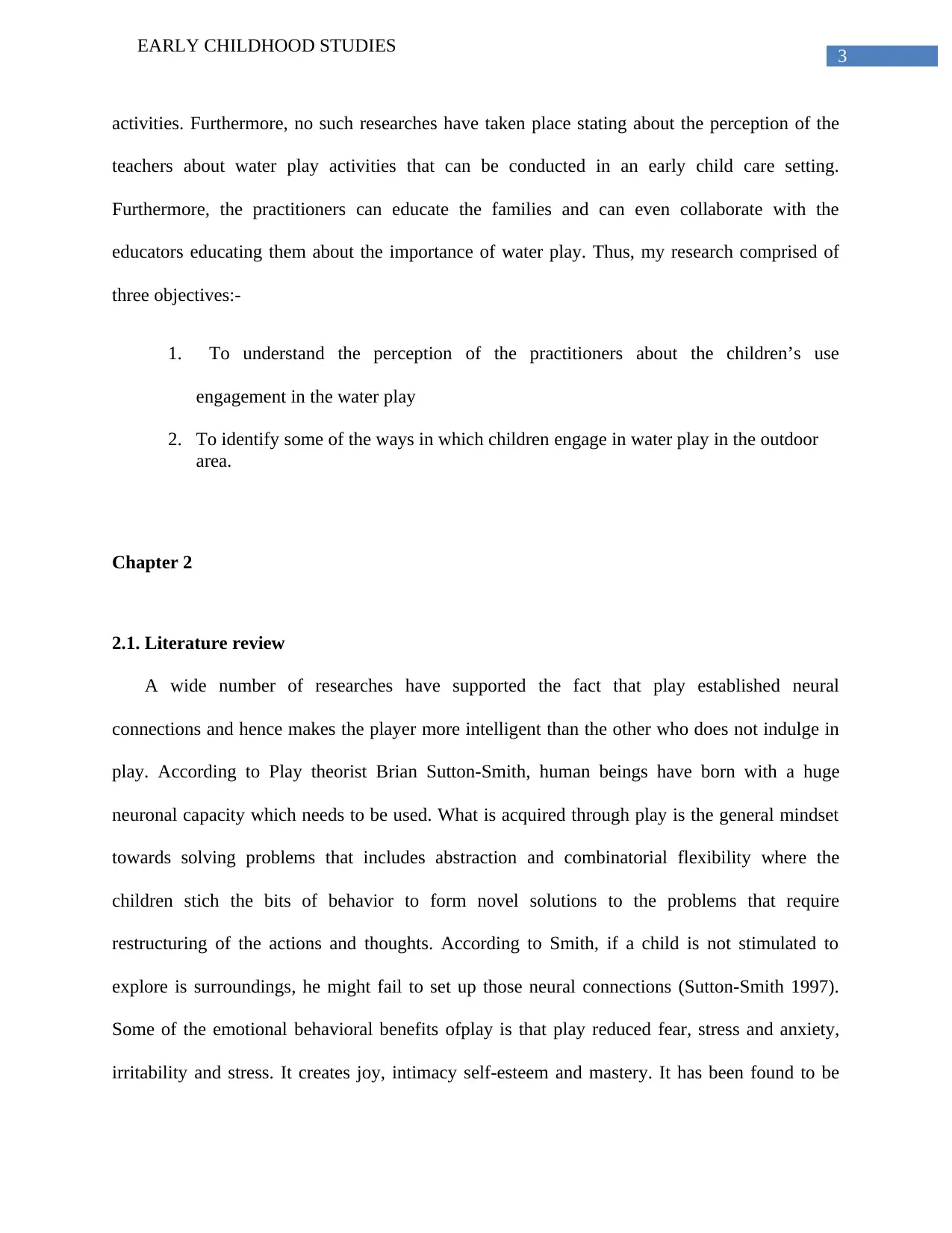
3
EARLY CHILDHOOD STUDIES
activities. Furthermore, no such researches have taken place stating about the perception of the
teachers about water play activities that can be conducted in an early child care setting.
Furthermore, the practitioners can educate the families and can even collaborate with the
educators educating them about the importance of water play. Thus, my research comprised of
three objectives:-
1. To understand the perception of the practitioners about the children’s use
engagement in the water play
2. To identify some of the ways in which children engage in water play in the outdoor
area.
Chapter 2
2.1. Literature review
A wide number of researches have supported the fact that play established neural
connections and hence makes the player more intelligent than the other who does not indulge in
play. According to Play theorist Brian Sutton-Smith, human beings have born with a huge
neuronal capacity which needs to be used. What is acquired through play is the general mindset
towards solving problems that includes abstraction and combinatorial flexibility where the
children stich the bits of behavior to form novel solutions to the problems that require
restructuring of the actions and thoughts. According to Smith, if a child is not stimulated to
explore is surroundings, he might fail to set up those neural connections (Sutton-Smith 1997).
Some of the emotional behavioral benefits ofplay is that play reduced fear, stress and anxiety,
irritability and stress. It creates joy, intimacy self-esteem and mastery. It has been found to be
EARLY CHILDHOOD STUDIES
activities. Furthermore, no such researches have taken place stating about the perception of the
teachers about water play activities that can be conducted in an early child care setting.
Furthermore, the practitioners can educate the families and can even collaborate with the
educators educating them about the importance of water play. Thus, my research comprised of
three objectives:-
1. To understand the perception of the practitioners about the children’s use
engagement in the water play
2. To identify some of the ways in which children engage in water play in the outdoor
area.
Chapter 2
2.1. Literature review
A wide number of researches have supported the fact that play established neural
connections and hence makes the player more intelligent than the other who does not indulge in
play. According to Play theorist Brian Sutton-Smith, human beings have born with a huge
neuronal capacity which needs to be used. What is acquired through play is the general mindset
towards solving problems that includes abstraction and combinatorial flexibility where the
children stich the bits of behavior to form novel solutions to the problems that require
restructuring of the actions and thoughts. According to Smith, if a child is not stimulated to
explore is surroundings, he might fail to set up those neural connections (Sutton-Smith 1997).
Some of the emotional behavioral benefits ofplay is that play reduced fear, stress and anxiety,
irritability and stress. It creates joy, intimacy self-esteem and mastery. It has been found to be
Paraphrase This Document
Need a fresh take? Get an instant paraphrase of this document with our AI Paraphraser
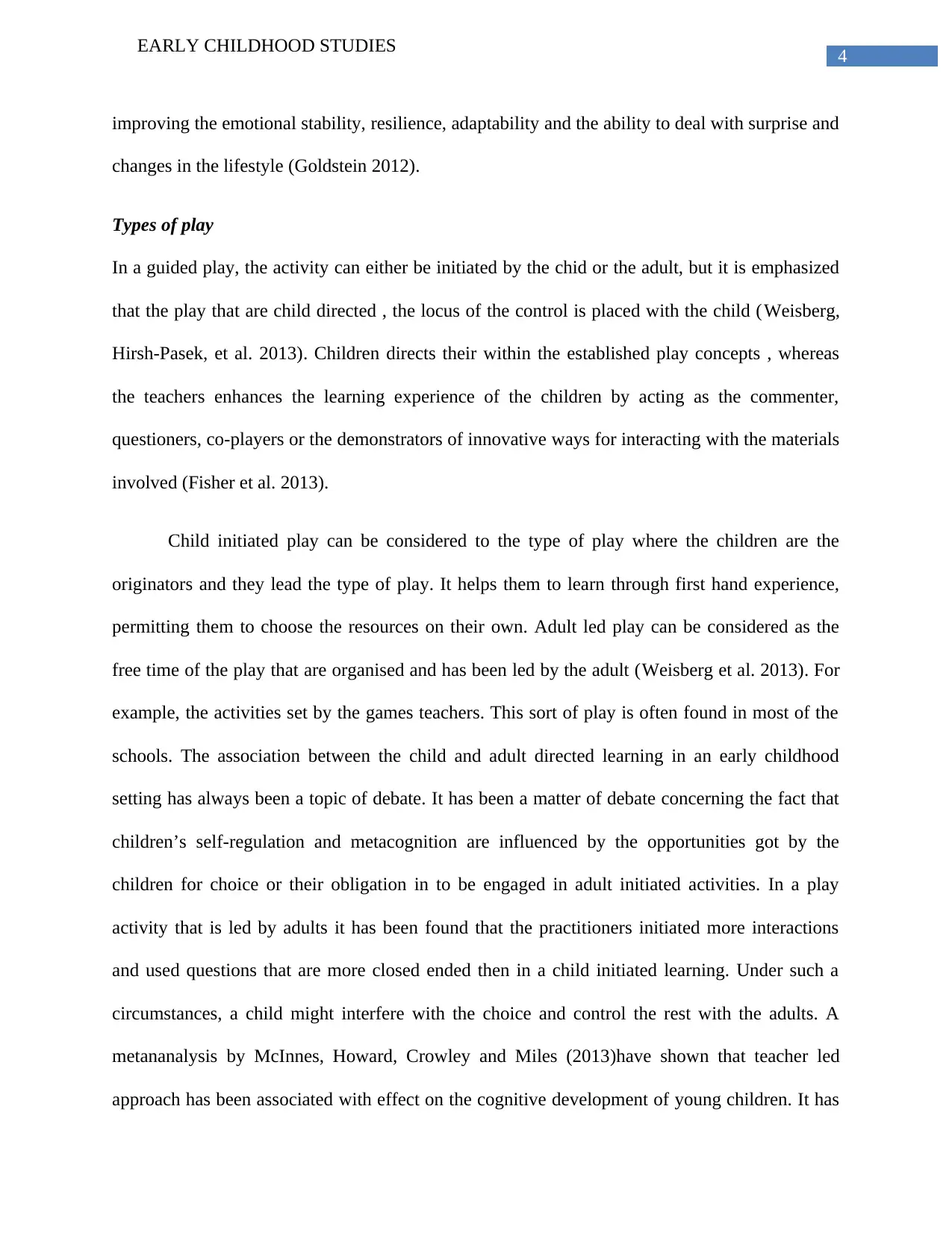
4
EARLY CHILDHOOD STUDIES
improving the emotional stability, resilience, adaptability and the ability to deal with surprise and
changes in the lifestyle (Goldstein 2012).
Types of play
In a guided play, the activity can either be initiated by the chid or the adult, but it is emphasized
that the play that are child directed , the locus of the control is placed with the child (Weisberg,
Hirsh-Pasek, et al. 2013). Children directs their within the established play concepts , whereas
the teachers enhances the learning experience of the children by acting as the commenter,
questioners, co-players or the demonstrators of innovative ways for interacting with the materials
involved (Fisher et al. 2013).
Child initiated play can be considered to the type of play where the children are the
originators and they lead the type of play. It helps them to learn through first hand experience,
permitting them to choose the resources on their own. Adult led play can be considered as the
free time of the play that are organised and has been led by the adult (Weisberg et al. 2013). For
example, the activities set by the games teachers. This sort of play is often found in most of the
schools. The association between the child and adult directed learning in an early childhood
setting has always been a topic of debate. It has been a matter of debate concerning the fact that
children’s self-regulation and metacognition are influenced by the opportunities got by the
children for choice or their obligation in to be engaged in adult initiated activities. In a play
activity that is led by adults it has been found that the practitioners initiated more interactions
and used questions that are more closed ended then in a child initiated learning. Under such a
circumstances, a child might interfere with the choice and control the rest with the adults. A
metananalysis by McInnes, Howard, Crowley and Miles (2013)have shown that teacher led
approach has been associated with effect on the cognitive development of young children. It has
EARLY CHILDHOOD STUDIES
improving the emotional stability, resilience, adaptability and the ability to deal with surprise and
changes in the lifestyle (Goldstein 2012).
Types of play
In a guided play, the activity can either be initiated by the chid or the adult, but it is emphasized
that the play that are child directed , the locus of the control is placed with the child (Weisberg,
Hirsh-Pasek, et al. 2013). Children directs their within the established play concepts , whereas
the teachers enhances the learning experience of the children by acting as the commenter,
questioners, co-players or the demonstrators of innovative ways for interacting with the materials
involved (Fisher et al. 2013).
Child initiated play can be considered to the type of play where the children are the
originators and they lead the type of play. It helps them to learn through first hand experience,
permitting them to choose the resources on their own. Adult led play can be considered as the
free time of the play that are organised and has been led by the adult (Weisberg et al. 2013). For
example, the activities set by the games teachers. This sort of play is often found in most of the
schools. The association between the child and adult directed learning in an early childhood
setting has always been a topic of debate. It has been a matter of debate concerning the fact that
children’s self-regulation and metacognition are influenced by the opportunities got by the
children for choice or their obligation in to be engaged in adult initiated activities. In a play
activity that is led by adults it has been found that the practitioners initiated more interactions
and used questions that are more closed ended then in a child initiated learning. Under such a
circumstances, a child might interfere with the choice and control the rest with the adults. A
metananalysis by McInnes, Howard, Crowley and Miles (2013)have shown that teacher led
approach has been associated with effect on the cognitive development of young children. It has
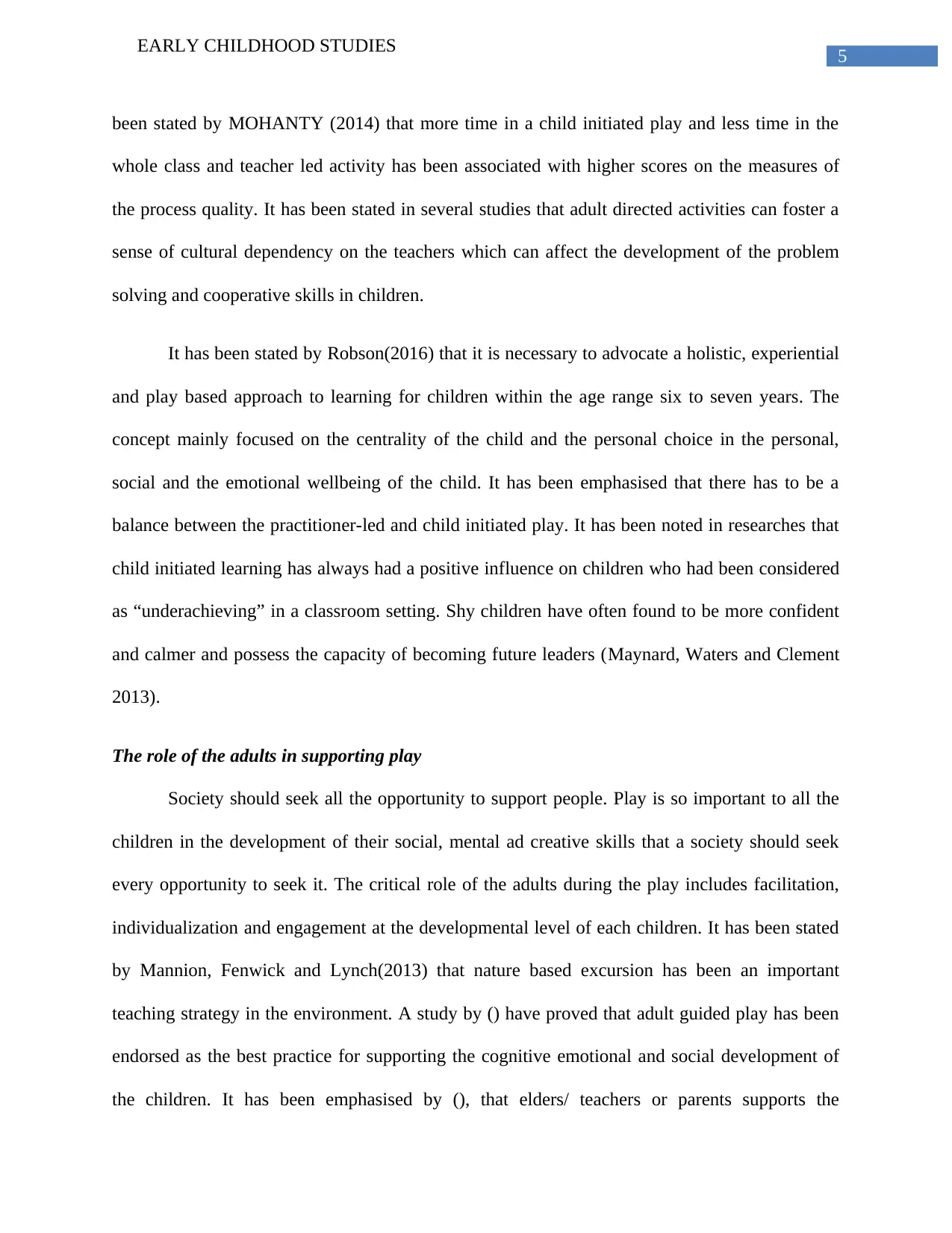
5
EARLY CHILDHOOD STUDIES
been stated by MOHANTY (2014) that more time in a child initiated play and less time in the
whole class and teacher led activity has been associated with higher scores on the measures of
the process quality. It has been stated in several studies that adult directed activities can foster a
sense of cultural dependency on the teachers which can affect the development of the problem
solving and cooperative skills in children.
It has been stated by Robson(2016) that it is necessary to advocate a holistic, experiential
and play based approach to learning for children within the age range six to seven years. The
concept mainly focused on the centrality of the child and the personal choice in the personal,
social and the emotional wellbeing of the child. It has been emphasised that there has to be a
balance between the practitioner-led and child initiated play. It has been noted in researches that
child initiated learning has always had a positive influence on children who had been considered
as “underachieving” in a classroom setting. Shy children have often found to be more confident
and calmer and possess the capacity of becoming future leaders (Maynard, Waters and Clement
2013).
The role of the adults in supporting play
Society should seek all the opportunity to support people. Play is so important to all the
children in the development of their social, mental ad creative skills that a society should seek
every opportunity to seek it. The critical role of the adults during the play includes facilitation,
individualization and engagement at the developmental level of each children. It has been stated
by Mannion, Fenwick and Lynch(2013) that nature based excursion has been an important
teaching strategy in the environment. A study by () have proved that adult guided play has been
endorsed as the best practice for supporting the cognitive emotional and social development of
the children. It has been emphasised by (), that elders/ teachers or parents supports the
EARLY CHILDHOOD STUDIES
been stated by MOHANTY (2014) that more time in a child initiated play and less time in the
whole class and teacher led activity has been associated with higher scores on the measures of
the process quality. It has been stated in several studies that adult directed activities can foster a
sense of cultural dependency on the teachers which can affect the development of the problem
solving and cooperative skills in children.
It has been stated by Robson(2016) that it is necessary to advocate a holistic, experiential
and play based approach to learning for children within the age range six to seven years. The
concept mainly focused on the centrality of the child and the personal choice in the personal,
social and the emotional wellbeing of the child. It has been emphasised that there has to be a
balance between the practitioner-led and child initiated play. It has been noted in researches that
child initiated learning has always had a positive influence on children who had been considered
as “underachieving” in a classroom setting. Shy children have often found to be more confident
and calmer and possess the capacity of becoming future leaders (Maynard, Waters and Clement
2013).
The role of the adults in supporting play
Society should seek all the opportunity to support people. Play is so important to all the
children in the development of their social, mental ad creative skills that a society should seek
every opportunity to seek it. The critical role of the adults during the play includes facilitation,
individualization and engagement at the developmental level of each children. It has been stated
by Mannion, Fenwick and Lynch(2013) that nature based excursion has been an important
teaching strategy in the environment. A study by () have proved that adult guided play has been
endorsed as the best practice for supporting the cognitive emotional and social development of
the children. It has been emphasised by (), that elders/ teachers or parents supports the
⊘ This is a preview!⊘
Do you want full access?
Subscribe today to unlock all pages.

Trusted by 1+ million students worldwide
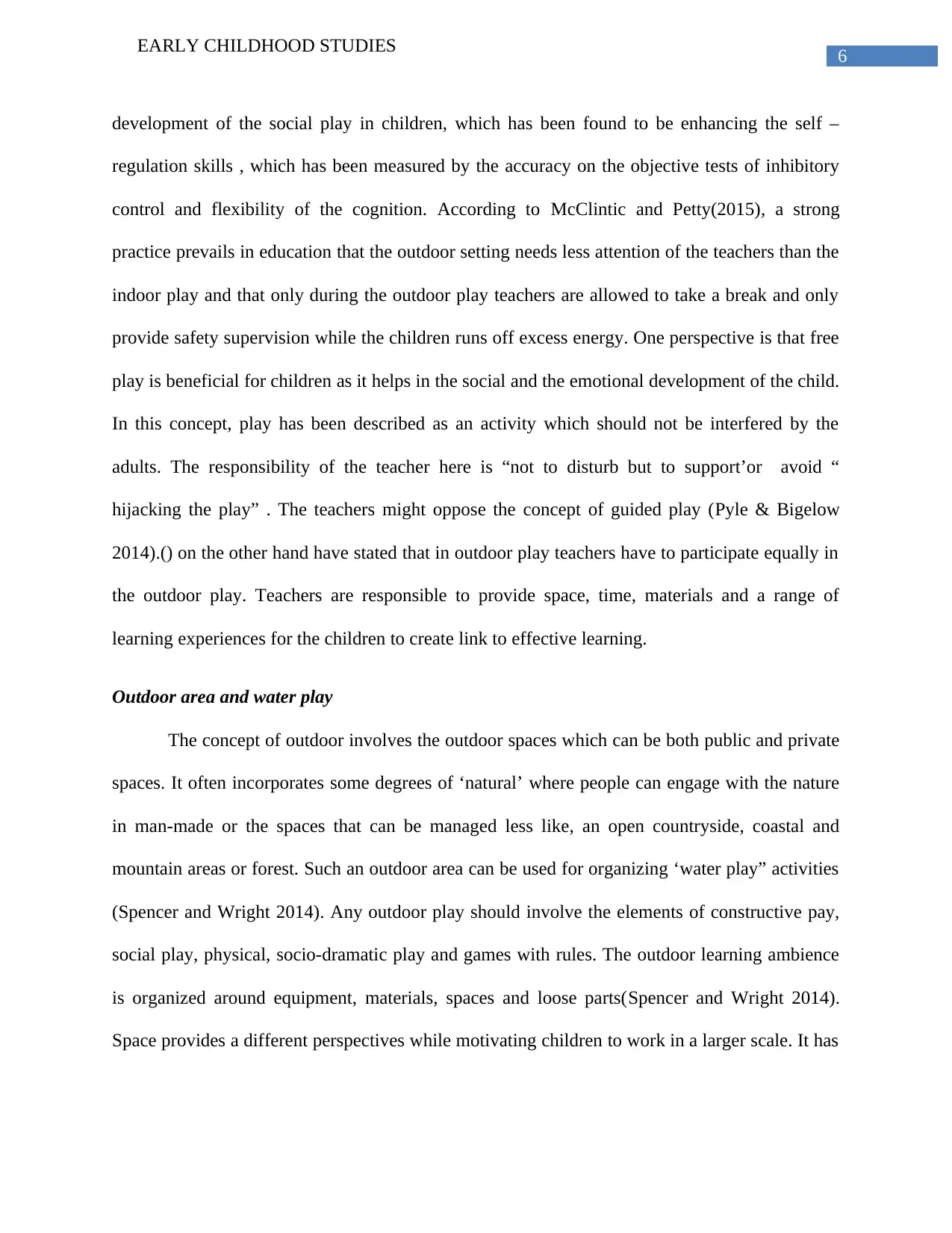
6
EARLY CHILDHOOD STUDIES
development of the social play in children, which has been found to be enhancing the self –
regulation skills , which has been measured by the accuracy on the objective tests of inhibitory
control and flexibility of the cognition. According to McClintic and Petty(2015), a strong
practice prevails in education that the outdoor setting needs less attention of the teachers than the
indoor play and that only during the outdoor play teachers are allowed to take a break and only
provide safety supervision while the children runs off excess energy. One perspective is that free
play is beneficial for children as it helps in the social and the emotional development of the child.
In this concept, play has been described as an activity which should not be interfered by the
adults. The responsibility of the teacher here is “not to disturb but to support’or avoid “
hijacking the play” . The teachers might oppose the concept of guided play (Pyle & Bigelow
2014).() on the other hand have stated that in outdoor play teachers have to participate equally in
the outdoor play. Teachers are responsible to provide space, time, materials and a range of
learning experiences for the children to create link to effective learning.
Outdoor area and water play
The concept of outdoor involves the outdoor spaces which can be both public and private
spaces. It often incorporates some degrees of ‘natural’ where people can engage with the nature
in man-made or the spaces that can be managed less like, an open countryside, coastal and
mountain areas or forest. Such an outdoor area can be used for organizing ‘water play” activities
(Spencer and Wright 2014). Any outdoor play should involve the elements of constructive pay,
social play, physical, socio-dramatic play and games with rules. The outdoor learning ambience
is organized around equipment, materials, spaces and loose parts(Spencer and Wright 2014).
Space provides a different perspectives while motivating children to work in a larger scale. It has
EARLY CHILDHOOD STUDIES
development of the social play in children, which has been found to be enhancing the self –
regulation skills , which has been measured by the accuracy on the objective tests of inhibitory
control and flexibility of the cognition. According to McClintic and Petty(2015), a strong
practice prevails in education that the outdoor setting needs less attention of the teachers than the
indoor play and that only during the outdoor play teachers are allowed to take a break and only
provide safety supervision while the children runs off excess energy. One perspective is that free
play is beneficial for children as it helps in the social and the emotional development of the child.
In this concept, play has been described as an activity which should not be interfered by the
adults. The responsibility of the teacher here is “not to disturb but to support’or avoid “
hijacking the play” . The teachers might oppose the concept of guided play (Pyle & Bigelow
2014).() on the other hand have stated that in outdoor play teachers have to participate equally in
the outdoor play. Teachers are responsible to provide space, time, materials and a range of
learning experiences for the children to create link to effective learning.
Outdoor area and water play
The concept of outdoor involves the outdoor spaces which can be both public and private
spaces. It often incorporates some degrees of ‘natural’ where people can engage with the nature
in man-made or the spaces that can be managed less like, an open countryside, coastal and
mountain areas or forest. Such an outdoor area can be used for organizing ‘water play” activities
(Spencer and Wright 2014). Any outdoor play should involve the elements of constructive pay,
social play, physical, socio-dramatic play and games with rules. The outdoor learning ambience
is organized around equipment, materials, spaces and loose parts(Spencer and Wright 2014).
Space provides a different perspectives while motivating children to work in a larger scale. It has
Paraphrase This Document
Need a fresh take? Get an instant paraphrase of this document with our AI Paraphraser
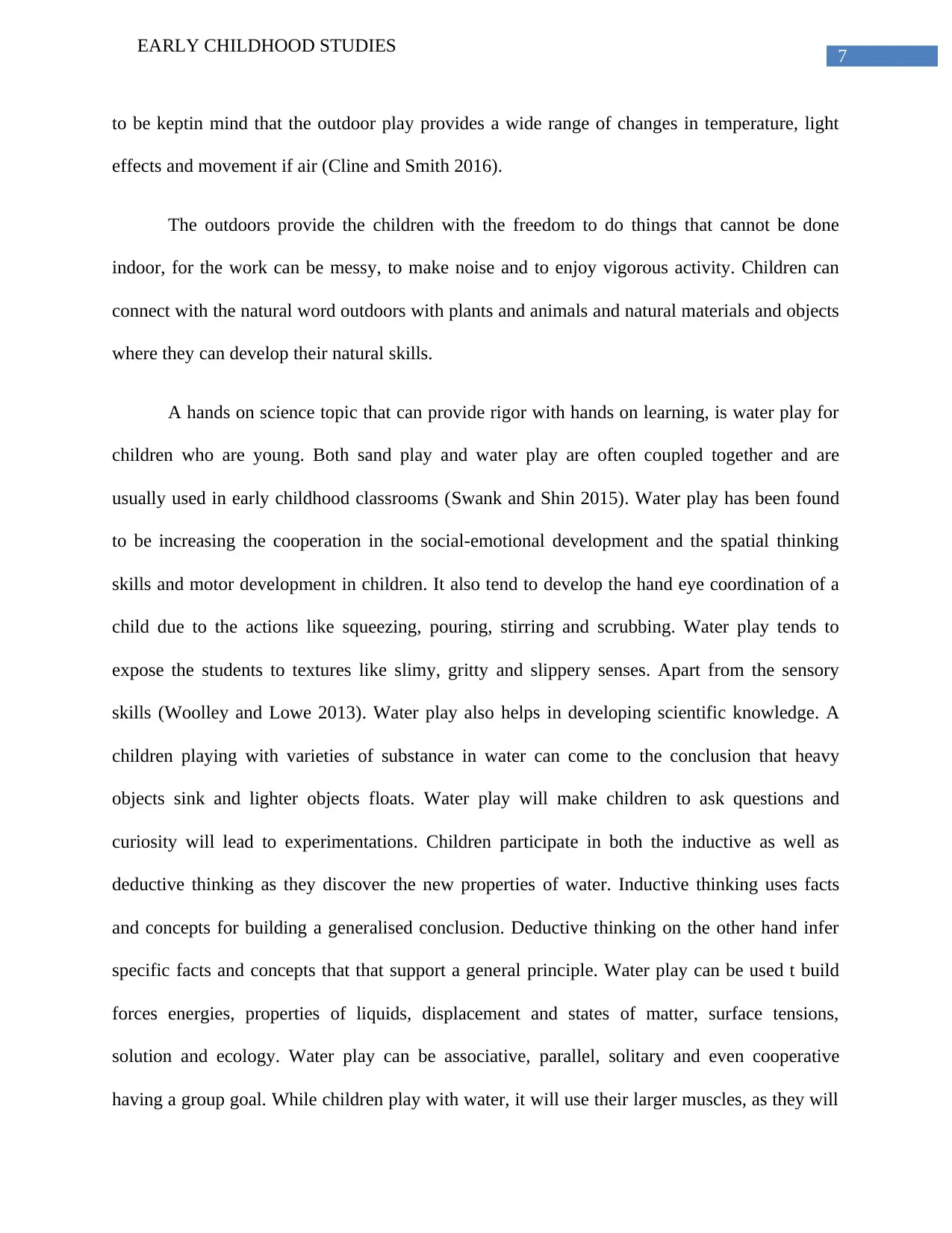
7
EARLY CHILDHOOD STUDIES
to be keptin mind that the outdoor play provides a wide range of changes in temperature, light
effects and movement if air (Cline and Smith 2016).
The outdoors provide the children with the freedom to do things that cannot be done
indoor, for the work can be messy, to make noise and to enjoy vigorous activity. Children can
connect with the natural word outdoors with plants and animals and natural materials and objects
where they can develop their natural skills.
A hands on science topic that can provide rigor with hands on learning, is water play for
children who are young. Both sand play and water play are often coupled together and are
usually used in early childhood classrooms (Swank and Shin 2015). Water play has been found
to be increasing the cooperation in the social-emotional development and the spatial thinking
skills and motor development in children. It also tend to develop the hand eye coordination of a
child due to the actions like squeezing, pouring, stirring and scrubbing. Water play tends to
expose the students to textures like slimy, gritty and slippery senses. Apart from the sensory
skills (Woolley and Lowe 2013). Water play also helps in developing scientific knowledge. A
children playing with varieties of substance in water can come to the conclusion that heavy
objects sink and lighter objects floats. Water play will make children to ask questions and
curiosity will lead to experimentations. Children participate in both the inductive as well as
deductive thinking as they discover the new properties of water. Inductive thinking uses facts
and concepts for building a generalised conclusion. Deductive thinking on the other hand infer
specific facts and concepts that that support a general principle. Water play can be used t build
forces energies, properties of liquids, displacement and states of matter, surface tensions,
solution and ecology. Water play can be associative, parallel, solitary and even cooperative
having a group goal. While children play with water, it will use their larger muscles, as they will
EARLY CHILDHOOD STUDIES
to be keptin mind that the outdoor play provides a wide range of changes in temperature, light
effects and movement if air (Cline and Smith 2016).
The outdoors provide the children with the freedom to do things that cannot be done
indoor, for the work can be messy, to make noise and to enjoy vigorous activity. Children can
connect with the natural word outdoors with plants and animals and natural materials and objects
where they can develop their natural skills.
A hands on science topic that can provide rigor with hands on learning, is water play for
children who are young. Both sand play and water play are often coupled together and are
usually used in early childhood classrooms (Swank and Shin 2015). Water play has been found
to be increasing the cooperation in the social-emotional development and the spatial thinking
skills and motor development in children. It also tend to develop the hand eye coordination of a
child due to the actions like squeezing, pouring, stirring and scrubbing. Water play tends to
expose the students to textures like slimy, gritty and slippery senses. Apart from the sensory
skills (Woolley and Lowe 2013). Water play also helps in developing scientific knowledge. A
children playing with varieties of substance in water can come to the conclusion that heavy
objects sink and lighter objects floats. Water play will make children to ask questions and
curiosity will lead to experimentations. Children participate in both the inductive as well as
deductive thinking as they discover the new properties of water. Inductive thinking uses facts
and concepts for building a generalised conclusion. Deductive thinking on the other hand infer
specific facts and concepts that that support a general principle. Water play can be used t build
forces energies, properties of liquids, displacement and states of matter, surface tensions,
solution and ecology. Water play can be associative, parallel, solitary and even cooperative
having a group goal. While children play with water, it will use their larger muscles, as they will
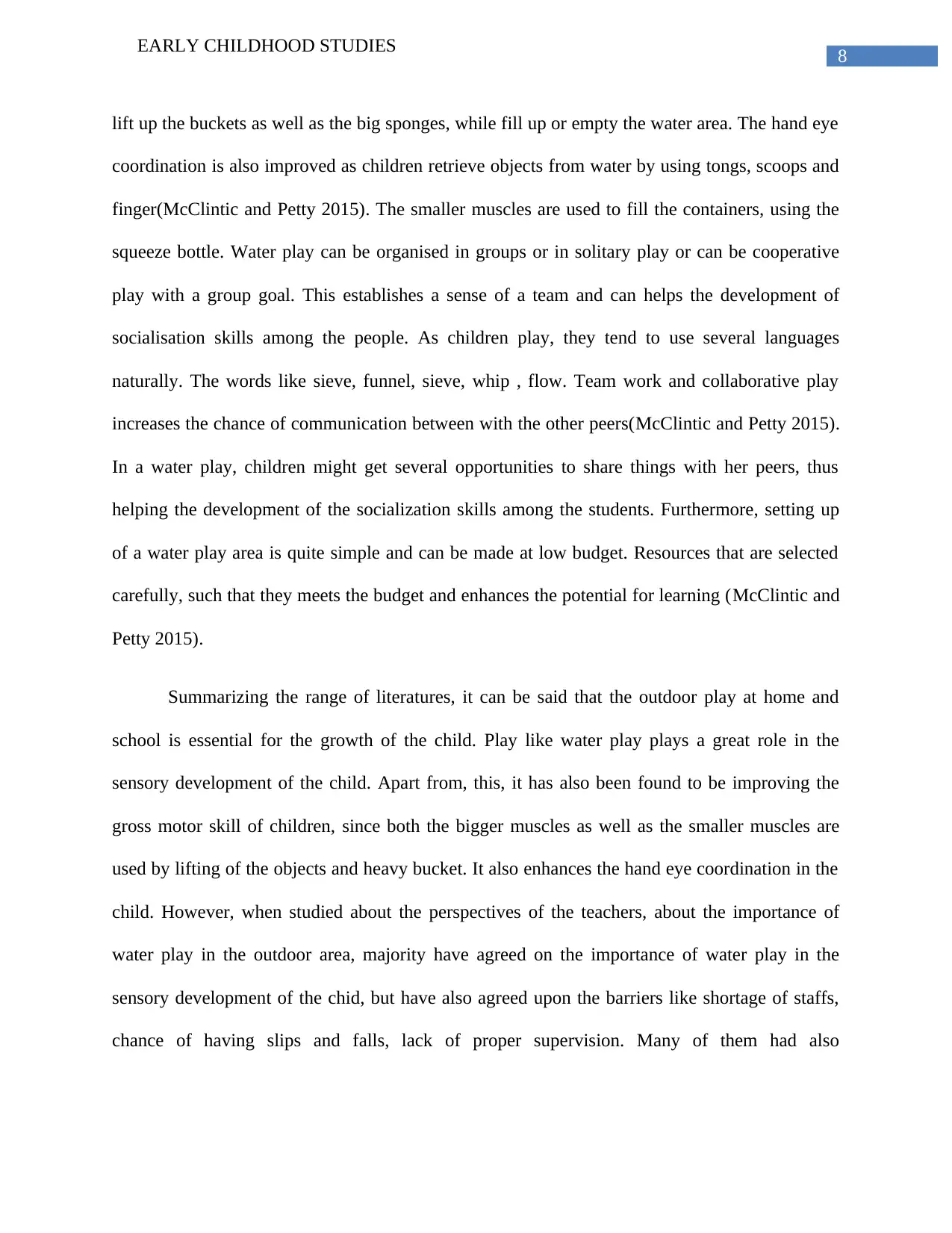
8
EARLY CHILDHOOD STUDIES
lift up the buckets as well as the big sponges, while fill up or empty the water area. The hand eye
coordination is also improved as children retrieve objects from water by using tongs, scoops and
finger(McClintic and Petty 2015). The smaller muscles are used to fill the containers, using the
squeeze bottle. Water play can be organised in groups or in solitary play or can be cooperative
play with a group goal. This establishes a sense of a team and can helps the development of
socialisation skills among the people. As children play, they tend to use several languages
naturally. The words like sieve, funnel, sieve, whip , flow. Team work and collaborative play
increases the chance of communication between with the other peers(McClintic and Petty 2015).
In a water play, children might get several opportunities to share things with her peers, thus
helping the development of the socialization skills among the students. Furthermore, setting up
of a water play area is quite simple and can be made at low budget. Resources that are selected
carefully, such that they meets the budget and enhances the potential for learning (McClintic and
Petty 2015).
Summarizing the range of literatures, it can be said that the outdoor play at home and
school is essential for the growth of the child. Play like water play plays a great role in the
sensory development of the child. Apart from, this, it has also been found to be improving the
gross motor skill of children, since both the bigger muscles as well as the smaller muscles are
used by lifting of the objects and heavy bucket. It also enhances the hand eye coordination in the
child. However, when studied about the perspectives of the teachers, about the importance of
water play in the outdoor area, majority have agreed on the importance of water play in the
sensory development of the chid, but have also agreed upon the barriers like shortage of staffs,
chance of having slips and falls, lack of proper supervision. Many of them had also
EARLY CHILDHOOD STUDIES
lift up the buckets as well as the big sponges, while fill up or empty the water area. The hand eye
coordination is also improved as children retrieve objects from water by using tongs, scoops and
finger(McClintic and Petty 2015). The smaller muscles are used to fill the containers, using the
squeeze bottle. Water play can be organised in groups or in solitary play or can be cooperative
play with a group goal. This establishes a sense of a team and can helps the development of
socialisation skills among the people. As children play, they tend to use several languages
naturally. The words like sieve, funnel, sieve, whip , flow. Team work and collaborative play
increases the chance of communication between with the other peers(McClintic and Petty 2015).
In a water play, children might get several opportunities to share things with her peers, thus
helping the development of the socialization skills among the students. Furthermore, setting up
of a water play area is quite simple and can be made at low budget. Resources that are selected
carefully, such that they meets the budget and enhances the potential for learning (McClintic and
Petty 2015).
Summarizing the range of literatures, it can be said that the outdoor play at home and
school is essential for the growth of the child. Play like water play plays a great role in the
sensory development of the child. Apart from, this, it has also been found to be improving the
gross motor skill of children, since both the bigger muscles as well as the smaller muscles are
used by lifting of the objects and heavy bucket. It also enhances the hand eye coordination in the
child. However, when studied about the perspectives of the teachers, about the importance of
water play in the outdoor area, majority have agreed on the importance of water play in the
sensory development of the chid, but have also agreed upon the barriers like shortage of staffs,
chance of having slips and falls, lack of proper supervision. Many of them had also
⊘ This is a preview!⊘
Do you want full access?
Subscribe today to unlock all pages.

Trusted by 1+ million students worldwide
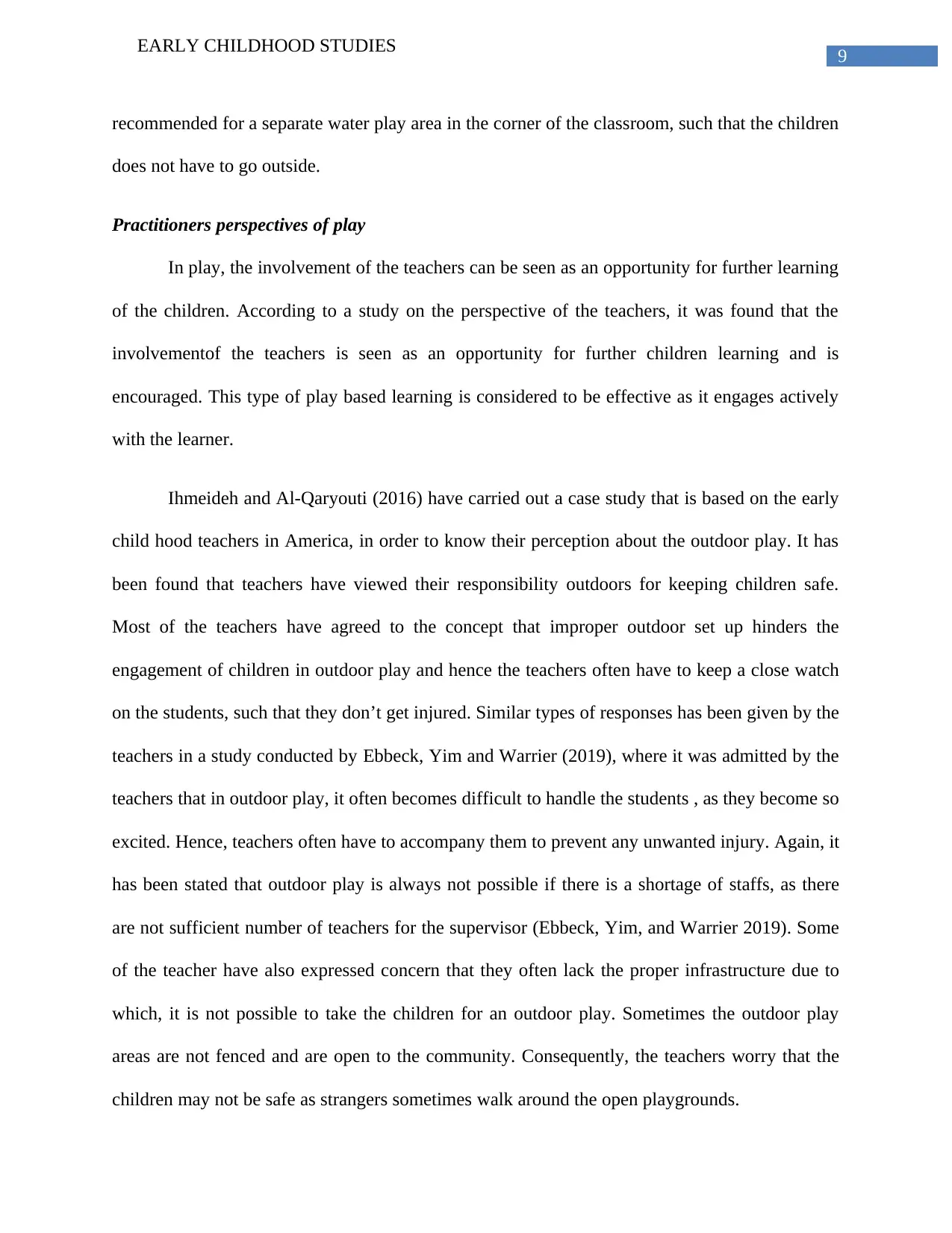
9
EARLY CHILDHOOD STUDIES
recommended for a separate water play area in the corner of the classroom, such that the children
does not have to go outside.
Practitioners perspectives of play
In play, the involvement of the teachers can be seen as an opportunity for further learning
of the children. According to a study on the perspective of the teachers, it was found that the
involvementof the teachers is seen as an opportunity for further children learning and is
encouraged. This type of play based learning is considered to be effective as it engages actively
with the learner.
Ihmeideh and Al-Qaryouti (2016) have carried out a case study that is based on the early
child hood teachers in America, in order to know their perception about the outdoor play. It has
been found that teachers have viewed their responsibility outdoors for keeping children safe.
Most of the teachers have agreed to the concept that improper outdoor set up hinders the
engagement of children in outdoor play and hence the teachers often have to keep a close watch
on the students, such that they don’t get injured. Similar types of responses has been given by the
teachers in a study conducted by Ebbeck, Yim and Warrier (2019), where it was admitted by the
teachers that in outdoor play, it often becomes difficult to handle the students , as they become so
excited. Hence, teachers often have to accompany them to prevent any unwanted injury. Again, it
has been stated that outdoor play is always not possible if there is a shortage of staffs, as there
are not sufficient number of teachers for the supervisor (Ebbeck, Yim, and Warrier 2019). Some
of the teacher have also expressed concern that they often lack the proper infrastructure due to
which, it is not possible to take the children for an outdoor play. Sometimes the outdoor play
areas are not fenced and are open to the community. Consequently, the teachers worry that the
children may not be safe as strangers sometimes walk around the open playgrounds.
EARLY CHILDHOOD STUDIES
recommended for a separate water play area in the corner of the classroom, such that the children
does not have to go outside.
Practitioners perspectives of play
In play, the involvement of the teachers can be seen as an opportunity for further learning
of the children. According to a study on the perspective of the teachers, it was found that the
involvementof the teachers is seen as an opportunity for further children learning and is
encouraged. This type of play based learning is considered to be effective as it engages actively
with the learner.
Ihmeideh and Al-Qaryouti (2016) have carried out a case study that is based on the early
child hood teachers in America, in order to know their perception about the outdoor play. It has
been found that teachers have viewed their responsibility outdoors for keeping children safe.
Most of the teachers have agreed to the concept that improper outdoor set up hinders the
engagement of children in outdoor play and hence the teachers often have to keep a close watch
on the students, such that they don’t get injured. Similar types of responses has been given by the
teachers in a study conducted by Ebbeck, Yim and Warrier (2019), where it was admitted by the
teachers that in outdoor play, it often becomes difficult to handle the students , as they become so
excited. Hence, teachers often have to accompany them to prevent any unwanted injury. Again, it
has been stated that outdoor play is always not possible if there is a shortage of staffs, as there
are not sufficient number of teachers for the supervisor (Ebbeck, Yim, and Warrier 2019). Some
of the teacher have also expressed concern that they often lack the proper infrastructure due to
which, it is not possible to take the children for an outdoor play. Sometimes the outdoor play
areas are not fenced and are open to the community. Consequently, the teachers worry that the
children may not be safe as strangers sometimes walk around the open playgrounds.
Paraphrase This Document
Need a fresh take? Get an instant paraphrase of this document with our AI Paraphraser
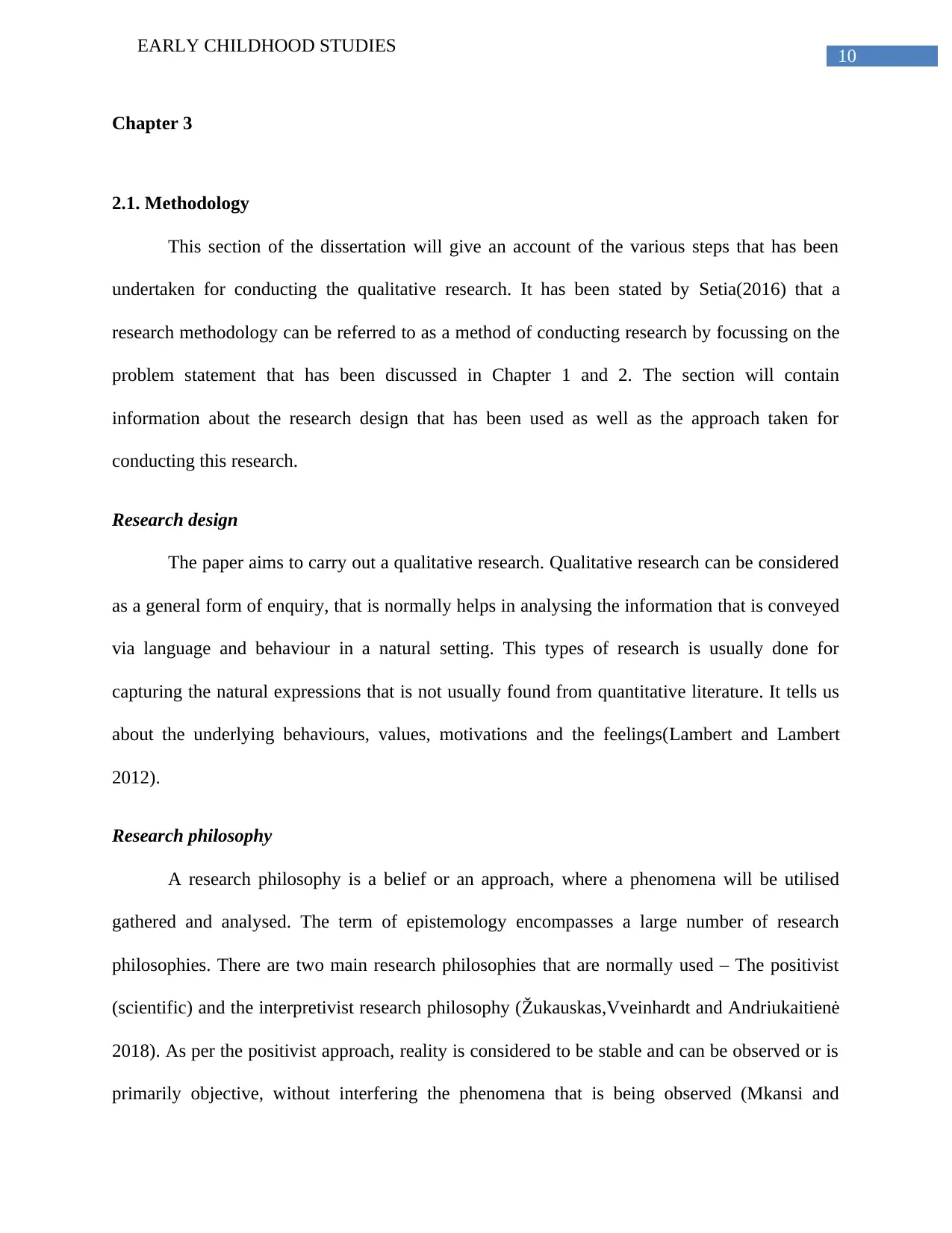
10
EARLY CHILDHOOD STUDIES
Chapter 3
2.1. Methodology
This section of the dissertation will give an account of the various steps that has been
undertaken for conducting the qualitative research. It has been stated by Setia(2016) that a
research methodology can be referred to as a method of conducting research by focussing on the
problem statement that has been discussed in Chapter 1 and 2. The section will contain
information about the research design that has been used as well as the approach taken for
conducting this research.
Research design
The paper aims to carry out a qualitative research. Qualitative research can be considered
as a general form of enquiry, that is normally helps in analysing the information that is conveyed
via language and behaviour in a natural setting. This types of research is usually done for
capturing the natural expressions that is not usually found from quantitative literature. It tells us
about the underlying behaviours, values, motivations and the feelings(Lambert and Lambert
2012).
Research philosophy
A research philosophy is a belief or an approach, where a phenomena will be utilised
gathered and analysed. The term of epistemology encompasses a large number of research
philosophies. There are two main research philosophies that are normally used – The positivist
(scientific) and the interpretivist research philosophy (Žukauskas,Vveinhardt and Andriukaitienė
2018). As per the positivist approach, reality is considered to be stable and can be observed or is
primarily objective, without interfering the phenomena that is being observed (Mkansi and
EARLY CHILDHOOD STUDIES
Chapter 3
2.1. Methodology
This section of the dissertation will give an account of the various steps that has been
undertaken for conducting the qualitative research. It has been stated by Setia(2016) that a
research methodology can be referred to as a method of conducting research by focussing on the
problem statement that has been discussed in Chapter 1 and 2. The section will contain
information about the research design that has been used as well as the approach taken for
conducting this research.
Research design
The paper aims to carry out a qualitative research. Qualitative research can be considered
as a general form of enquiry, that is normally helps in analysing the information that is conveyed
via language and behaviour in a natural setting. This types of research is usually done for
capturing the natural expressions that is not usually found from quantitative literature. It tells us
about the underlying behaviours, values, motivations and the feelings(Lambert and Lambert
2012).
Research philosophy
A research philosophy is a belief or an approach, where a phenomena will be utilised
gathered and analysed. The term of epistemology encompasses a large number of research
philosophies. There are two main research philosophies that are normally used – The positivist
(scientific) and the interpretivist research philosophy (Žukauskas,Vveinhardt and Andriukaitienė
2018). As per the positivist approach, reality is considered to be stable and can be observed or is
primarily objective, without interfering the phenomena that is being observed (Mkansi and
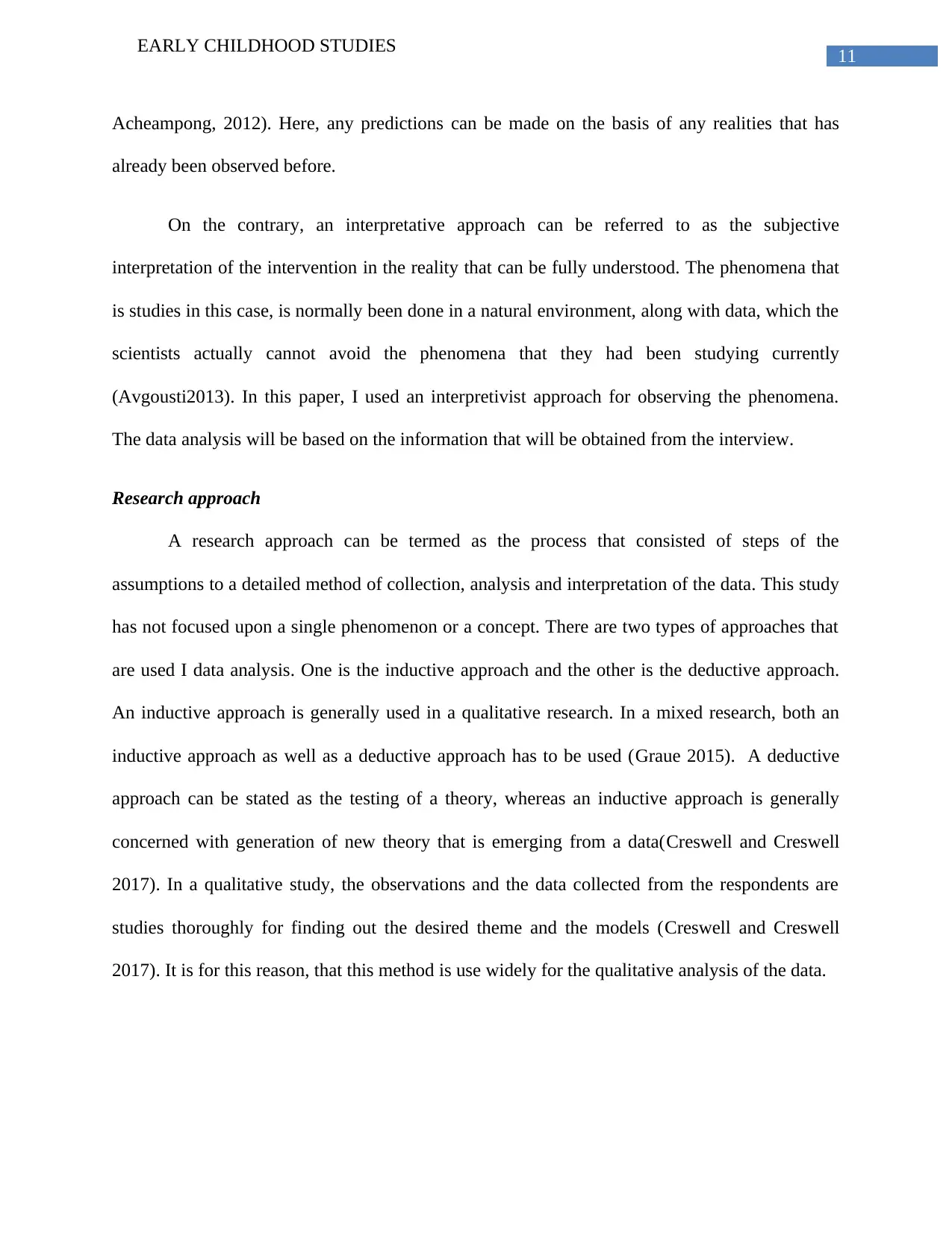
11
EARLY CHILDHOOD STUDIES
Acheampong, 2012). Here, any predictions can be made on the basis of any realities that has
already been observed before.
On the contrary, an interpretative approach can be referred to as the subjective
interpretation of the intervention in the reality that can be fully understood. The phenomena that
is studies in this case, is normally been done in a natural environment, along with data, which the
scientists actually cannot avoid the phenomena that they had been studying currently
(Avgousti2013). In this paper, I used an interpretivist approach for observing the phenomena.
The data analysis will be based on the information that will be obtained from the interview.
Research approach
A research approach can be termed as the process that consisted of steps of the
assumptions to a detailed method of collection, analysis and interpretation of the data. This study
has not focused upon a single phenomenon or a concept. There are two types of approaches that
are used I data analysis. One is the inductive approach and the other is the deductive approach.
An inductive approach is generally used in a qualitative research. In a mixed research, both an
inductive approach as well as a deductive approach has to be used (Graue 2015). A deductive
approach can be stated as the testing of a theory, whereas an inductive approach is generally
concerned with generation of new theory that is emerging from a data(Creswell and Creswell
2017). In a qualitative study, the observations and the data collected from the respondents are
studies thoroughly for finding out the desired theme and the models (Creswell and Creswell
2017). It is for this reason, that this method is use widely for the qualitative analysis of the data.
EARLY CHILDHOOD STUDIES
Acheampong, 2012). Here, any predictions can be made on the basis of any realities that has
already been observed before.
On the contrary, an interpretative approach can be referred to as the subjective
interpretation of the intervention in the reality that can be fully understood. The phenomena that
is studies in this case, is normally been done in a natural environment, along with data, which the
scientists actually cannot avoid the phenomena that they had been studying currently
(Avgousti2013). In this paper, I used an interpretivist approach for observing the phenomena.
The data analysis will be based on the information that will be obtained from the interview.
Research approach
A research approach can be termed as the process that consisted of steps of the
assumptions to a detailed method of collection, analysis and interpretation of the data. This study
has not focused upon a single phenomenon or a concept. There are two types of approaches that
are used I data analysis. One is the inductive approach and the other is the deductive approach.
An inductive approach is generally used in a qualitative research. In a mixed research, both an
inductive approach as well as a deductive approach has to be used (Graue 2015). A deductive
approach can be stated as the testing of a theory, whereas an inductive approach is generally
concerned with generation of new theory that is emerging from a data(Creswell and Creswell
2017). In a qualitative study, the observations and the data collected from the respondents are
studies thoroughly for finding out the desired theme and the models (Creswell and Creswell
2017). It is for this reason, that this method is use widely for the qualitative analysis of the data.
⊘ This is a preview!⊘
Do you want full access?
Subscribe today to unlock all pages.

Trusted by 1+ million students worldwide
1 out of 28
Related Documents
Your All-in-One AI-Powered Toolkit for Academic Success.
+13062052269
info@desklib.com
Available 24*7 on WhatsApp / Email
![[object Object]](/_next/static/media/star-bottom.7253800d.svg)
Unlock your academic potential
Copyright © 2020–2025 A2Z Services. All Rights Reserved. Developed and managed by ZUCOL.




